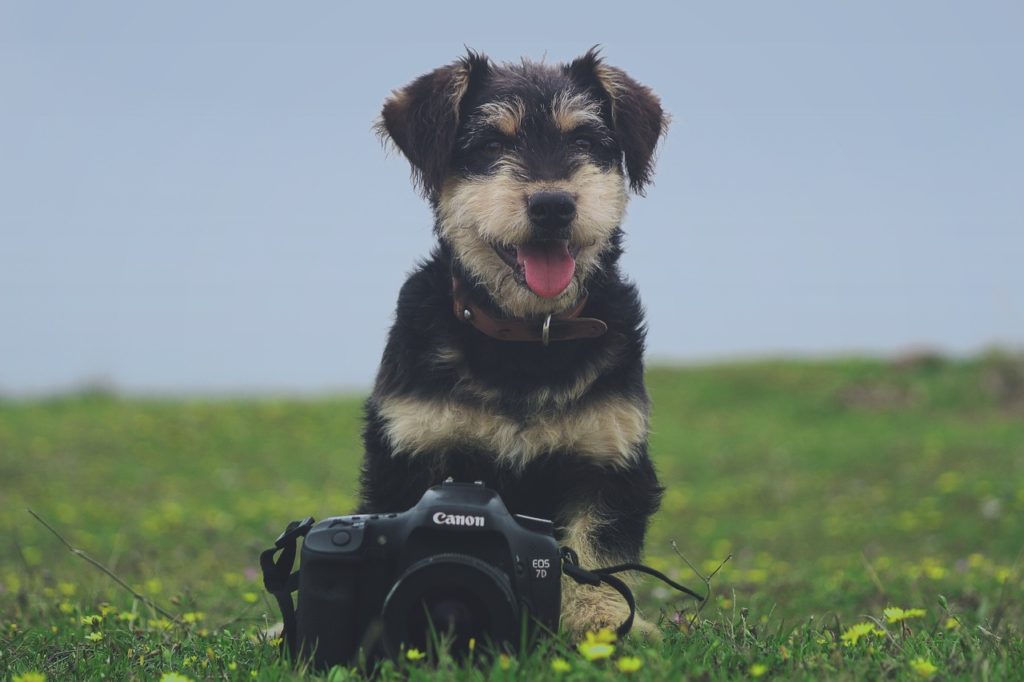
Capturing Canine Charm: Top Tips for Dog Photography
Dog photography is an art that goes beyond simply pointing and shooting. Upgrade with these dog photography tips.
Capturing the essence of our furry friends requires a combination of patience, skill, and a deep understanding of canine behavior.
Let’s explore some dog photography tips and tricks to help you elevate your game and immortalize those precious moments with your four-legged companions.
Dog Photography Tips #1: Get Down to Their Level
Getting down to the dog’s level is a fundamental and effective technique in dog photography that can significantly enhance the quality and impact of your shots.
This approach aims to capture images from the perspective of the dog, creating a more intimate connection between the viewer and the subject.

6 Dog Photography Tips: Why and how you should get down to their level:
- Create Intimacy: Dogs live close to the ground, experiencing the world from a lower vantage point. By getting down to their level, you bridge the gap between the human and canine perspective. This creates a more intimate and relatable experience for the viewer, as they get a glimpse of the world as the dog sees it.
- Showcase Proportions: Getting down to the dog’s eye level allows you to showcase their proportions more accurately. You can capture the full range of their size, from the tip of their nose to the end of their tail. This is particularly important when photographing puppies or large breeds, as it emphasizes their unique physical characteristics.
- Highlight Facial Expressions: The face is often the most expressive part of a dog’s body. When you’re at their eye level, you can capture the nuances of their facial expressions more effectively. This includes the sparkle in their eyes, the twitch of their nose, and the shape of their mouth. These details add depth and emotion to your photographs.
- Emphasize Connection: Dogs are incredibly social animals, and capturing the connection between a human and a dog is a powerful storytelling element. By being at their eye level, you naturally convey a sense of connection and understanding between the photographer (you) and the subject (the dog). This connection resonates with viewers, creating a more engaging and emotionally charged photograph.
- Avoid Dominance: Standing over a dog can be perceived as a dominant or threatening posture, especially if the dog is unfamiliar with you or your camera equipment. Getting down to their level reduces the chances of your presence being perceived as intimidating, resulting in a more relaxed and natural demeanor from the dog.
- Background Composition: Shooting from the dog’s level allows you to incorporate the background more effectively into your compositions. Whether it’s a natural landscape, a cityscape, or simply your home environment, the background becomes an integral part of the storytelling process. This adds context to the image and enhances the overall visual appeal.
Getting down to a dog’s level is a simple yet impactful technique that can transform your dog photography.
It brings viewers into the world of the dog, creating a connection that goes beyond a mere visual appreciation.
So, kneel, crouch, or lie down – whatever it takes to align your perspective with your furry friend’s – and watch as your dog photography tips takes on a new dimension of depth and authenticity.
Dog Photography Tips #2: Use Natural Light
Using natural light is a key element in dog photography that can significantly enhance the quality and mood of your images.
Natural light provides a soft, flattering illumination that brings out the best in your canine subjects.
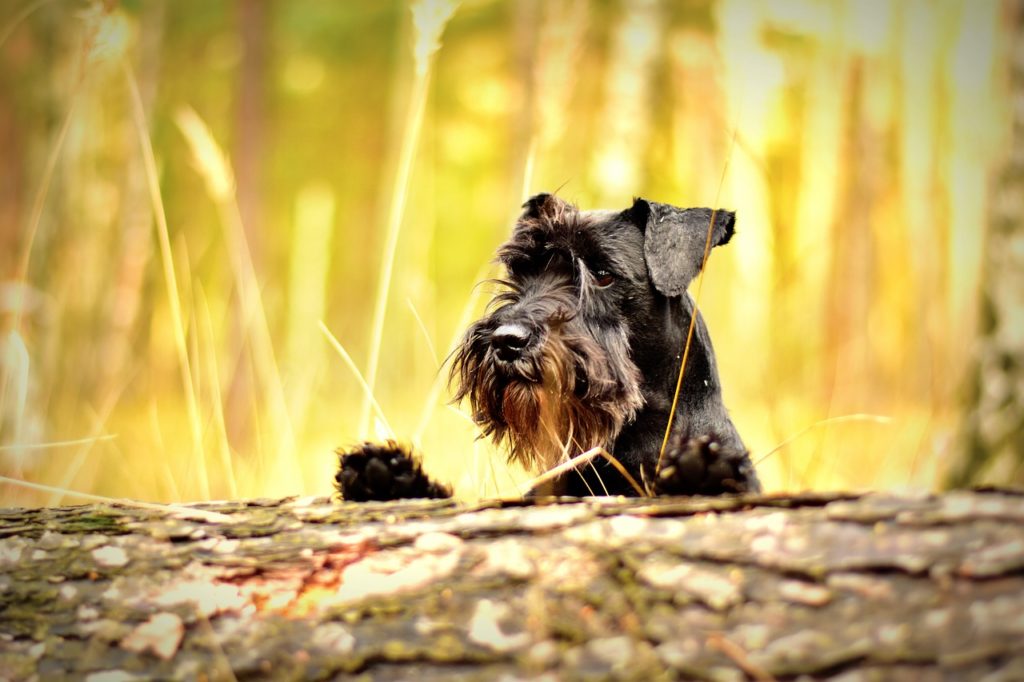
8 Dog Photography Tips: Why and how you should make the most of natural light in your dog photography:
- Soft and Flattering Illumination: Natural light, especially during the golden hours of early morning or late afternoon, offers a soft and warm glow that is ideal for capturing the details and textures of your dog’s fur. This gentle illumination creates a flattering effect, minimizing harsh shadows and highlights, and producing a more natural and appealing look.
- Avoid Harsh Midday Sun: The midday sun can cast strong, unflattering shadows and cause your dog to squint. To achieve the best results, schedule your photography sessions during the golden hours when the sun is low in the sky. This not only ensures a more even and pleasant light but also provides a beautiful, golden ambiance to your images.
- Emphasize Catchlights in the Eyes: Natural light often produces beautiful catchlights in your dog’s eyes, adding a spark of life and personality to the photograph. Position your dog so that the light source, whether it’s the sun or a window, reflects in their eyes. This technique enhances the focus on the eyes, creating a connection between the viewer and the subject.
- Utilize Shaded Areas: While natural light is wonderful, it’s essential to be mindful of its intensity. In cases where the sunlight is too harsh, look for shaded areas to achieve a more even and diffused lighting. Shaded spots can help eliminate strong contrasts, making it easier to capture details without losing important highlights or shadows.
- Maximize Indoor Natural Light: If you’re shooting indoors, position your dog near large windows to maximize natural light. This technique not only provides a soft and diffused illumination but also allows for interesting plays of light and shadow. Be aware of the direction of the light source to achieve the desired effects.
- Consider Overcast Days: Overcast days can be a blessing for dog photography. The cloud cover acts as a natural diffuser, creating soft and even lighting conditions. On such days, you can capture stunning portraits without worrying about harsh sunlight or distracting shadows.
- Experiment with Backlighting: Experimenting with backlighting can yield captivating results. Position your dog with the light source behind them to create a halo effect around their fur. This technique not only emphasizes the outline of your dog but also adds a touch of warmth and magic to the overall composition.
- Be Mindful of Reflections: Natural light can create interesting reflections, especially when shooting outdoors. Consider how reflective surfaces, such as water or even wet pavement after rain, can add an extra dimension to your dog photography tips. These reflections can contribute to the storytelling aspect of your images.
Harnessing the power of natural light is a fundamental aspect of dog photography tips.
Whether you’re shooting outdoors or indoors, understanding how to work with natural light can elevate your images, bringing out the best in your canine subjects and creating visually stunning and emotionally resonant photographs.
So, embrace the beauty of natural light and let it enhance the charm of your furry friends in every shot.
#3: Focus on the Eyes
Focusing on the eyes is a critical aspect of dog photography tip that can make the difference between a good shot and an extraordinary one.
The eyes are often considered the windows to the soul, and capturing them in a photograph can convey a deep sense of emotion and connection.
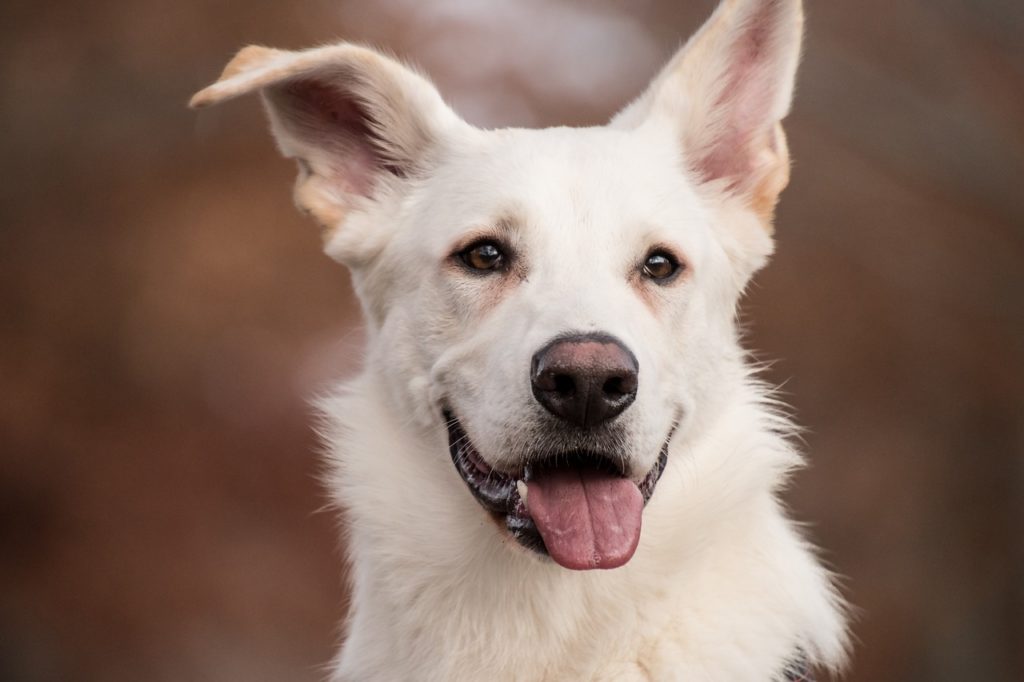
Seven Dog Photography Tips: Why and how you should prioritize focusing on the eyes in your dog photography:
- Convey Emotion and Personality: The eyes are incredibly expressive, and they play a crucial role in conveying the emotions and personality of your canine subject. By ensuring that the eyes are sharp and in focus, you capture the essence of your dog’s feelings – whether it’s joy, curiosity, or a soulful gaze. This adds a layer of depth and authenticity to your dog photography tips.
- Create a Connection with the Viewer: Focused eyes in a photograph create a direct connection with the viewer. When people look at an image, they instinctively seek eye contact. By having sharp, well-focused eyes in your dog photos, you invite viewers to connect with the subject on a more personal and emotional level. This connection enhances the impact and memorability of your images.
- Guide the Viewer’s Attention: The eyes serve as a natural focal point in any photograph. When they are in sharp focus, they naturally draw the viewer’s attention. This helps guide the viewer’s gaze to the most important part of the image – the dog’s expression. A well-focused gaze can tell a story and evoke emotions more effectively than any other element in the frame.
- Use a Wide Aperture for Shallow Depth of Field: Achieving sharp focus on the eyes often involves using a wide aperture to create a shallow depth of field. This technique helps isolate the eyes from the background, making them stand out more prominently. The background blur, or bokeh, not only adds a pleasing aesthetic but also ensures that the viewer’s attention remains on the eyes.
- Be Patient and Wait for the Right Moment: Dogs, like humans, have fleeting expressions and moments of emotion. Patience is key in dog photography. Spend time observing your dog, be attuned to their behavior, and be ready to capture that perfect moment when their eyes tell a story. Waiting for the right moment ensures that you capture genuine emotions rather than staged poses.
- Capture Catchlights: Catchlights are reflections of light in the eyes that add a sparkle and vitality to the gaze. Position your dog so that natural light or artificial light sources create catchlights in their eyes. These reflections not only enhance the visual appeal of the eyes but also bring them to life, making them more engaging for the viewer.
- Experiment with Different Angles: Explore different angles to capture the eyes from various perspectives. Whether it’s a close-up shot from the front, a profile view, or a shot from above, each angle offers a unique way to showcase the eyes and their expressions. Experimenting with angles adds variety and interest to your dog photography portfolio.
Focusing on the eyes is a powerful technique in dog photography that elevates the emotional impact of your images.
It establishes a connection between the viewer and your canine subject, making your photographs more relatable and memorable.
So, pay close attention to those soulful eyes, and let them speak volumes in each frame, telling the unique story of your furry friend.
Dog Photography Tips #4: Capture Action Shots
Capturing action shots is an exhilarating aspect of dog photography that adds a dynamic and energetic flair to your images.
Dogs are known for their playful and active nature, and freezing those moments in action can result in some of the most endearing and lively photographs.
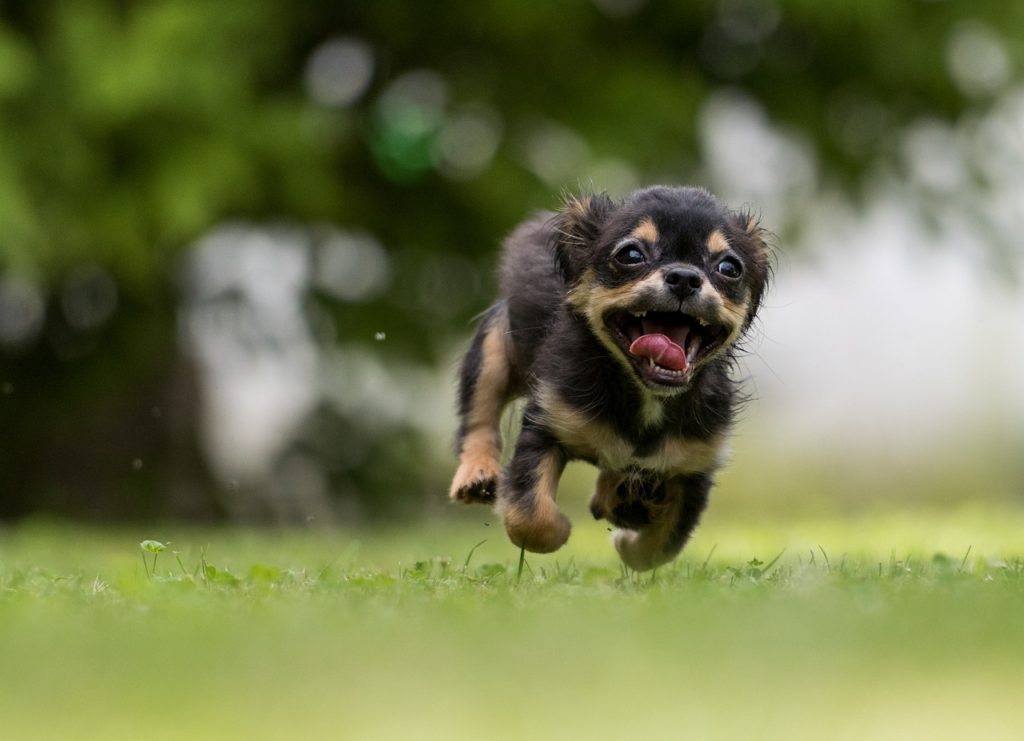
9 Dog Photography Tips: Why and how you should aim to capture action shots in your dog photography:
- Showcase Energy and Enthusiasm: Dogs are full of boundless energy, and action shots are a fantastic way to showcase their enthusiasm for life. Whether it’s a game of fetch, a joyful sprint, or a playful jump, freezing these moments in time allows you to convey the inherent joy and vitality that dogs bring to our lives.
- Use a Fast Shutter Speed: The key to capturing action shots is using a fast shutter speed. This ensures that the motion is frozen and details are sharp. Set your camera to a shutter speed of at least 1/500th of a second or faster to effectively freeze the action. This is particularly important when dealing with fast-paced movements.
- Anticipate the Action: Knowing your dog’s behavior and anticipating their movements is crucial for capturing the perfect action shot. Whether it’s predicting the trajectory of a jump or the direction of a sprint, being one step ahead allows you to frame the shot effectively and ensures you don’t miss those fleeting moments.
- Continuous Shooting Mode: Dogs are unpredictable, and action happens in split seconds. Use your camera’s continuous shooting mode to capture a rapid series of shots with a single press of the shutter button. This increases the chances of getting that perfectly timed action shot and provides you with a sequence to choose from.
- Focus on the Eyes: Even in action shots, maintaining focus on the eyes is essential. Sharp, focused eyes add a sense of intensity and emotion to the photograph. Use continuous autofocus mode to track your dog’s movements and keep the eyes in focus throughout the action sequence.
- Experiment with Angles and Perspectives: Action shots offer an excellent opportunity to experiment with different angles and perspectives. Get down to ground level to capture a running dog from their eye level or shoot from above to emphasize the dynamic movement. Changing perspectives adds variety and interest to your action shots.
- Include the Surroundings: While the focus is on the action, don’t forget to include elements of the surroundings in your shots. A flying leap in a scenic park or a splash in the water can provide context to the action, making your images more visually appealing and telling a more complete story.
- Embrace Blurred Motion: While freezing the action is often the goal, embracing a bit of motion blur can also convey a sense of speed and excitement. Experiment with slower shutter speeds to intentionally introduce motion blur, adding a dynamic and artistic touch to your action shots.
- Patience and Persistence: Capturing the perfect action shot requires patience and persistence. Dogs may not always cooperate, and getting the timing just right can take some time. Be prepared to shoot multiple frames and be patient in waiting for that ideal moment of action.
Action shots in dog photography tips are all about capturing the dynamic and lively essence of our furry friends.
With the right techniques and a keen eye for anticipating movements, you can freeze those energetic moments and create images that convey the joy and vitality of life with dogs.
Gear up, be ready for the action, and let your camera capture the spirited energy of your canine companions.
#5: Express Their Personality
Expressing the personality of your furry friend is a key element in dog photography tips that transforms images from mere portraits to captivating character studies.
Dogs, like humans, have unique personalities, quirks, and expressions that make them truly individual.
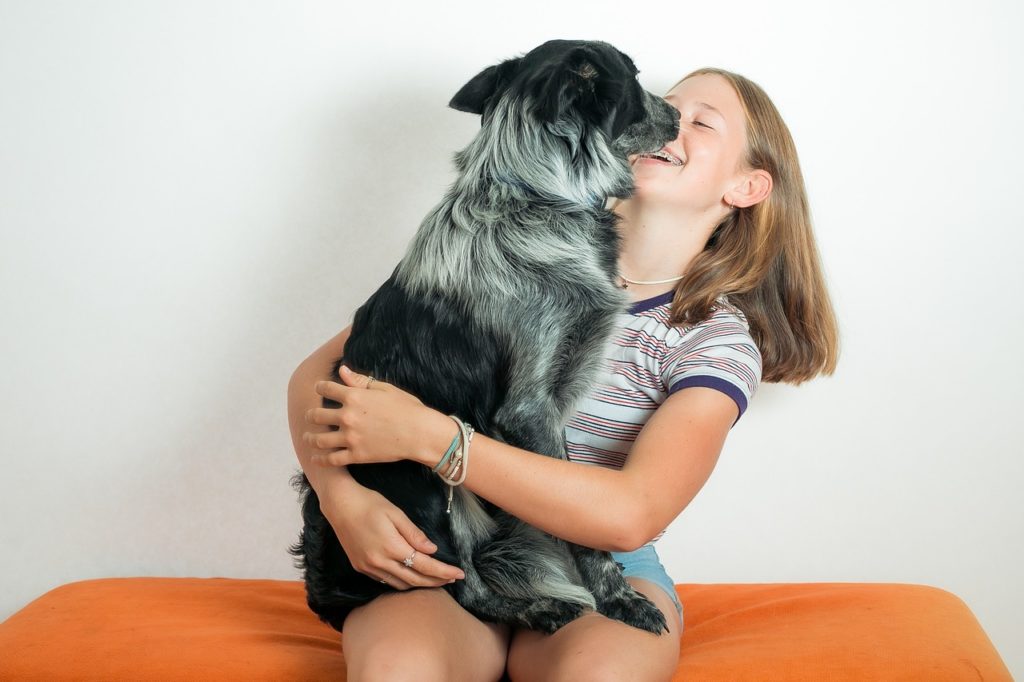
9 Dog Photography Tips: Why and how you should focus on expressing the personality of your dog in your photography:
- Celebrate Individuality: Every dog has a distinct personality, and showcasing that individuality in your photographs creates a connection between the viewer and the subject. Whether your dog is playful, shy, goofy, or dignified, capturing their unique traits allows viewers to relate and empathize with the canine personality.
- Observe and Understand: Spending time observing your dog’s behavior and understanding their personality is crucial. Recognize the expressions, habits, and moods that define your dog. This awareness enables you to anticipate and capture those moments that best express their personality, creating a more authentic and relatable portrayal.
- Capture Candid Moments: Candid shots often reveal the most genuine expressions of a dog’s personality. Allow your dog to be themselves and engage in their natural behaviors. Whether it’s a spontaneous play, a contemplative moment, or a goofy expression, candid shots capture the essence of your dog’s personality in its purest form.
- Highlight Quirks and Traits: Dogs often have endearing quirks and unique traits that make them special. Whether it’s a particular tilt of the head, a funny way of sitting, or a playful paw gesture, focus on capturing these distinctive characteristics. These details add charm and personality to your images.
- Create a Comfortable Environment: Dogs are more likely to express their true personality when they are comfortable and at ease. Choose familiar locations or settings where your dog feels relaxed. This could be their favorite park, your backyard, or even inside your home. A comfortable environment encourages natural and genuine expressions.
- Use Props and Accessories: Props and accessories can be used creatively to enhance and express your dog’s personality. Whether it’s a favorite toy, a stylish collar, or even seasonal accessories, these elements can add a personal touch and tell a story about your dog’s interests and preferences.
- Focus on Expressive Features: Pay special attention to the features that convey emotion and personality, such as the eyes, ears, and mouth. Dogs communicate a lot through these expressive features, and capturing them in detail allows viewers to connect with the emotions and character traits of your canine companion.
- Experiment with Different Moods: Dogs, like humans, have a range of moods. Experiment with capturing your dog in different emotional states – from playful and exuberant to calm and contemplative. Each mood reveals a different facet of their personality, creating a diverse and rich collection of images.
- Tell a Story: Build a narrative through your photographs that tells the story of your dog’s personality. Arrange a series of images that showcase different aspects of their character, creating a visual journey that resonates with viewers. A well-curated series of images can be both entertaining and emotionally engaging.
Expressing the personality of your dog in photography is a delightful way to celebrate the unique bond between humans and their canine companions.
By observing, understanding, and creatively capturing the individuality of your dog, you create images that go beyond the surface, allowing viewers to connect on a personal level and appreciate the diverse and charming personalities of our furry friends.
Let your dog’s personality shine through the lens, and enjoy the process of capturing those special moments that make them truly one of a kind.
Dog Photography Tips #6: Use Treats and Toys
In dog photography tips, using treats and toys is not just a trick for getting attention; it’s a valuable tool that can help you capture engaging and expressive images of your furry subject.
Whether you’re looking to achieve a focused gaze, a playful expression, or simply want to keep your dog’s attention during a photo shoot, treats and toys play a crucial role in creating vibrant and dynamic photographs.
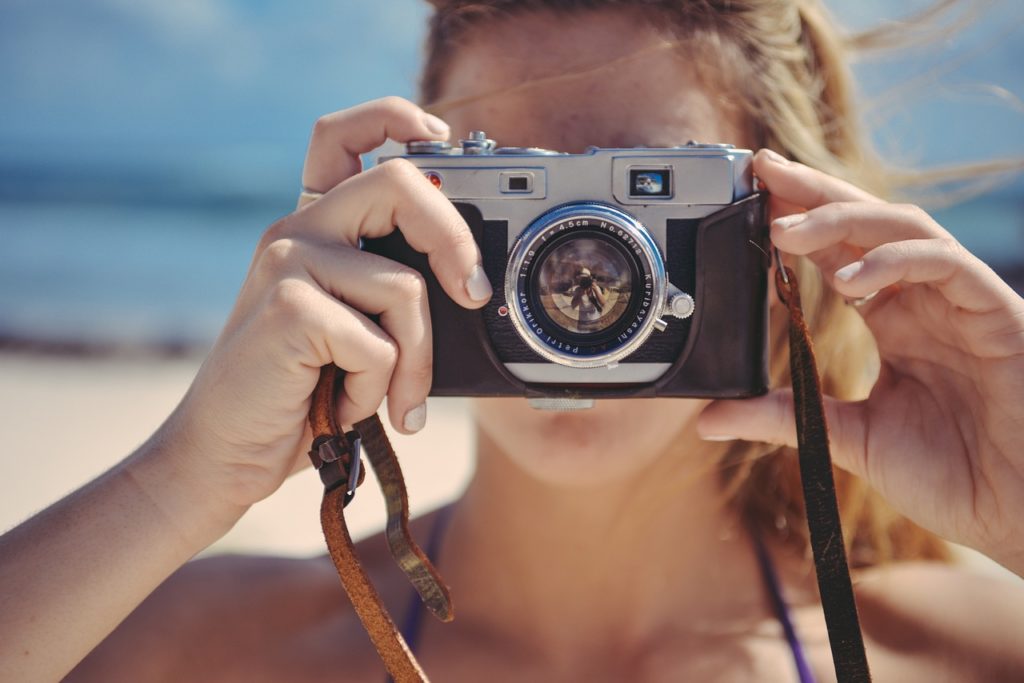
8 Dog Photography Tips: How you can effectively use treats and toys in your dog photography:
- Capture Expressive Faces: Treats and toys can be used to grab your dog’s attention and prompt various facial expressions. Hold a treat near your camera to encourage your dog to look directly into the lens. This technique not only creates a strong connection with the viewer but also allows you to capture detailed and expressive faces.
- Encourage Playfulness: Toys are fantastic for bringing out your dog’s playful side. Whether it’s a ball, a squeaky toy, or a favorite plush, incorporating toys into the photo shoot can result in images that showcase the joy and energy of your dog. Capture moments of playfulness, like a mid-air jump or an excited tail wag, for dynamic and lively shots.
- Create Engagement: Engage your dog with treats or toys to create a sense of interaction in your photographs. This interaction not only adds interest to the image but also conveys a deeper connection between the dog and the viewer. Genuine engagement often leads to more natural and charming expressions.
- Use as Positive Reinforcement: Treats can serve as positive reinforcement during a photo shoot, especially if your dog is still learning to be comfortable in front of the camera. Rewarding your dog with treats for good behavior helps create a positive association with the photography session, making them more cooperative and willing to participate.
- Direct Focus and Poses: Holding a treat or a toy strategically can help you guide your dog’s focus and encourage specific poses. For example, you can use a treat to direct your dog’s gaze upward or a toy to prompt them to sit or lie down. This control over their attention allows you to compose shots with intention and precision.
- Maintain Attention: Dogs can easily get distracted, especially in new environments. Treats and toys act as attention grabbers, helping you maintain your dog’s focus on the camera. Use them strategically to redirect attention when needed, ensuring that you capture the desired moments without distractions.
- Capture Candid Moments: While treats and toys are great for directed shots, they can also be used to capture candid moments. Throw a toy and capture the joyous chase or toss treats in the air for a delightful mid-air catch. These spontaneous actions result in authentic and heartwarming images.
- Experiment with Expressions: Play around with treats to capture different expressions. A treat held just out of reach might create a look of anticipation or determination, while a treat near the nose can lead to a content and focused expression. Experimenting with treats allows you to explore the range of emotions your dog can convey.
Remember to use treats and toys in moderation, ensuring that they enhance the photography experience without overwhelming or distracting your dog.
Building a positive association with treats and toys can turn your photo sessions into enjoyable and rewarding experiences for both you and your furry model.
So, stock up on your dog’s favorite treats, gather their cherished toys, and let the creativity flow in capturing delightful and expressive moments through the lens.
#7: Patience is Key
In the realm of dog photography, patience is not just a virtue; it’s an indispensable skill that can make the difference between a good shot and an exceptional one.
Dogs, with their playful and often unpredictable nature, require a patient approach to capture those genuine, heartwarming moments.
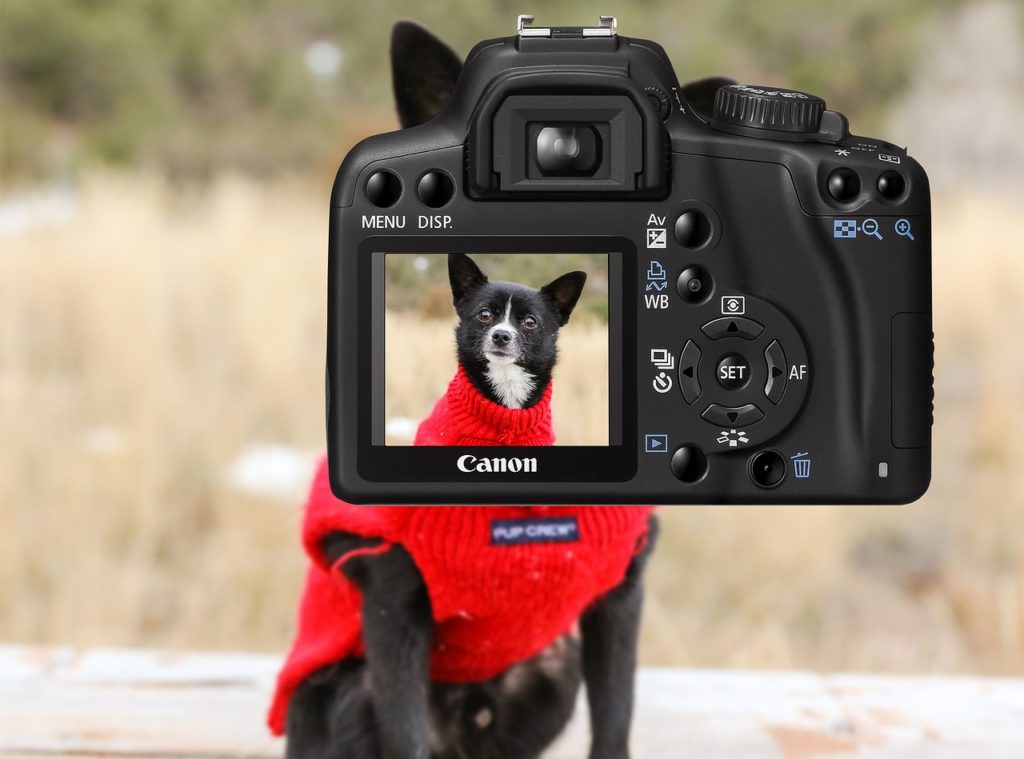
8 Dog Photography Tips: Why patience is key in dog photography and how it contributes to the creation of remarkable images:
- Building Trust: Patience is crucial in building trust between you and the dog. Approaching slowly, allowing them to get familiar with your presence and the camera, builds a sense of comfort. This trust is essential for capturing authentic expressions and natural behavior without causing stress or anxiety.
- Observing Behavior: Dogs are expressive beings with a wide range of behaviors. Patience allows you to observe and understand your dog’s unique movements, reactions, and habits. By patiently waiting and watching, you can anticipate moments that reveal their personality, creating a more meaningful and authentic photographic narrative.
- Capturing Genuine Expressions: Genuine expressions are often fleeting and spontaneous. Patience enables you to wait for those moments when your dog’s personality shines through – whether it’s a happy tail wag, a curious tilt of the head, or a content sigh. These unscripted moments result in photographs that tell a true and heartwarming story.
- Creating Relaxed Poses: For dogs, the camera can be an unfamiliar and sometimes intimidating object. Patience allows you to give your dog the time they need to relax and settle into the environment. Relaxed poses come from a calm and stress-free state, contributing to more natural and visually appealing photographs.
- Adapting to the Dog’s Pace: Each dog has its own pace and comfort level. Some dogs may be ready for the camera immediately, while others may need more time to acclimate. Patience involves adapting to the dog’s pace, allowing them to set the rhythm of the photo session. This adaptability ensures a smoother and more enjoyable experience for both you and the dog.
- Waiting for the Right Lighting: Patience is essential when working with natural light. Waiting for the golden hours during sunrise or sunset, when the light is soft and warm, can elevate the quality of your photographs. Patience also comes into play when dealing with overcast days or finding the perfect balance between light and shadow.
- Overcoming Challenges: Dogs can be unpredictable, and photo sessions may not always go as planned. Patience helps you overcome challenges, whether it’s a dog that’s camera-shy, easily distracted, or simply not in the mood. Patience allows you to adapt, find solutions, and turn unexpected moments into opportunities for creative shots.
- Fostering a Positive Experience: Patience contributes to a positive experience for both you and the dog. A relaxed and patient approach helps create an enjoyable atmosphere during the photo shoot. This positive experience not only results in better photographs but also strengthens the bond between you and your furry subject.
Patience is the foundation of successful dog photography tips.
It allows you to connect with your subject, observe their unique qualities, and capture moments that reflect their true essence.
Take a deep breath, embrace the unpredictable nature of working with dogs, and let patience guide you through the process of creating images that resonate with authenticity and warmth.
Conclusion to Dog Photography Tips
Dog photography is a delightful way to celebrate the special bond between humans and their canine companions.
By employing these dog photography tips, you can elevate your skills and create lasting memories that showcase the unique charm and personality of man’s best friend.
So, grab your camera, spend some quality time with your dog, and let the magic unfold through the lens.
